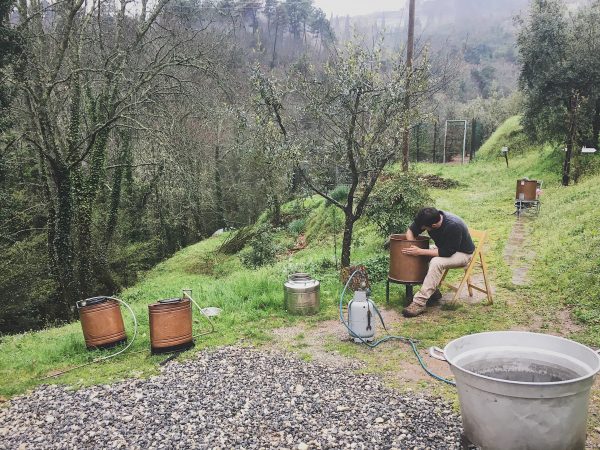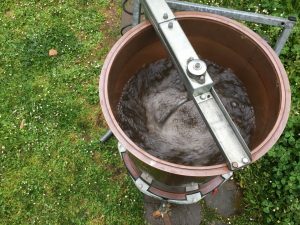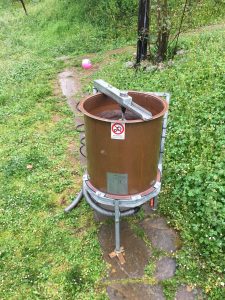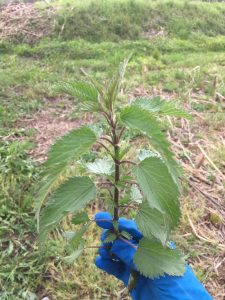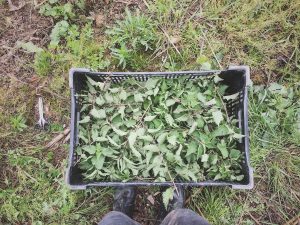I’m starting with the preparations because they are incredibly unique to biodynamic farming. These preparations were developed by Rudolf Steiner and Ehrenfied Pfeiffer and are sort of like a substitute to spraying synthetic and even organically certified fertilizers, but they aren’t fertilizers. They aid in the growth, health, and development of plants and all of the preparations are made using plant or animal matter, often in conjunction, that comes from the farm, or another farm that is Demeter (biodynamic) certified. There are nine different preparations that are serve a specific purpose for plant and soil health.
Preparation 500:
It is said to get its name because once it is made there are over 500 million aerobic bacteria per gram. I’m not sure if this has been scientifically tested, or if it was a number that Pfeiffer came up with due to the difficulties with culturing bacteria in a lab setting (many species refuse to grow in petri dishes for unknown reasons.) If Pfeiffer was correct then that is a lot of microbial activity happening. All of the other preparations were named sequentially after preparation 500. To make prep 500 you need some high-quality cow manure, from either your own cows, or cows that are from a biodynamic farm. Now what we’ve all been waiting for comes into the picture, the cow horn. The cow horn that is used should also come from a cow that has been raised biodynamically, which can be hard to get, but once you do it can be used for many years. The cow’s horn is then stuffed with cow manure and placed into the ground during the winter. Putting the cow horn in the cold ground is incredibly important for the transformation from manure to a very black, earthy smelling substance. If you were to put the cow horn in the ground during the summer there would be more microbial activity, which would turn the manure into something closer to compost. In the spring, the cow horn is dug up and the contents are placed in a glass jar with a loose-fitting lid to allow consistent air flow. Preparation 500’s intent is to promote the growth of plant roots, humus formation, and microbial activity.
This dense mass of what was once manure is then turned into a spray, which is applied once during the spring and once during the fall on a humid, overcast day, preferably when the moon is descending. To make the spray you take a small amount of 500 and place it into a very large copper pot (enamel, glazed earthenware, or stainless steel will also suffice) and add the purest water you can find. Ideally this water will come from the farm, generally from rain water, but a spring will also do quite well. It’s important not to use tap water because there are often additives such as chlorine, which will inhibit or kill microbes. After the water is added the stirring begins. At Nico, Federico has a machine that stirs one pot, but he needs three so in order to save time we stir one of the sprays by hand. The water is first heated between 25 degrees Celsius to 35 degrees Celsius over a gas flame in a large stainless-steel pot, once it reaches 35 degrees Celsius we transfer it to the copper pot.
Then the stirring begins, I started from the middle and did a rapid wrist twisting motion to make a vortex, once that was going strong I moved my hand to the outside of the whirlpool and continue to move it for a little longer, then I stopped the flow abruptly to add oxygen into the water. Creating a whirlpool begins immediately after in the same manner but in the opposite direction. This is continued for one hour to achieve the 500 million microbes per gram. Some say that you are supposed to have one person stirring the pot for the whole hour, but there were three of us on the farm so we split it into 20 minute intervals. Once complete the liquid is transferred into a spray unit, which can be copper, brass, or stainless steel, but it must never be plastic (refer to the photo at the top of the page, the objects on the left-hand side are the spraying units.) The nozzle in which the spray comes out of should be low pressure that produces large droplets. You walk up and down the orchard or field with a large copper container on your back and hand pump this spray onto the land. That’s 500 for you.
Preparation 501:
501 uses incredibly finely ground quartz crystal, which is also placed inside of a cow horn and put in the ground, but this time during the summer to utilize the sun’s power. The purpose of this prep is to stimulate activity in the upper part of the plant. It is supposed to enhance light metabolism, crisp moist plants that are susceptible to disease while promoting flavor, aroma and food value. All of the benefits are achieved through the dynamic activation of silica in the quartz crystal. Though you must be careful in very dry places where there is an abundance of light because it might work so well that all your plants are too crisp.
To make this prep into a spray the same process as 500 is applied, with the copper pots and the stirring. Though the nozzle of the spraying unit is different, instead of large droplets you want a very soft mist to land on top of the plants.
Preparations 502-507 are all put in the compost to help with humus formation rather than made into a spray.
Preparation 502:
Yarrow (Achillea millefolia) is used to make 502 due to its ability to change and store a large amount of soil minerals. Yarrow thrives in soil of poor quality, has a lot of potassium salt, and the flower contains sulfur.
To make the preparation you fill a stag’s bladder full of yarrow flowers in the early summer, let it dry out, burry it in the winter, and dig it up in the spring for use.
Preparation 503:
Chamomile (Matricaria chamomilla), which has been used by humans to lower inflammation and sooth the digestive tract is also used in biodynamics as a way to balance calcium in the compost. The chamomile flowers are made into tea then put into a cow’s small intestine, which is then placed into the ground in the winter, dug up in the spring, and then put in the compost.
Preparation 504:
Stinging Nettle (Urtica dioca) is special because it activates circulatory precession in humans and animals. Stinging nettles are rich in potassium, calcium, nitrate, silicic acid, formic acid, iron, tannic acid, mucus wax, and carotin. In the past they were used as a blood tonic and today it is used to help with anemia. To make this preparation the nettles are placed directly in the ground, where they stay for a year before being dug up and placed in the compost.
The name for nettle in Italian is ortica, but Federico was asking me to harvest this plant and wanted to say it in English. He was struggling with the “stinging” part of the name only pronouncing the “s” when he asked me to say the name. I said stinging nettle of course and his response was, “Sting. Like the singer?” This is now how he remembers the name in English.
Preparation 505:
Oak tree (Quercus robur) is used for its high amounts of calcium that will aid in soil health as well as its ability to make plants more disease-resistant. The bark of the oak tree is scrapped and placed into the skull of a domesticated animal (goat, sheep, cow, etc.) and buried in the ground in the fall, near a place where water can drip into the skull, perhaps under a leaky pipe. The skull is then dug up in the spring and the contents are placed in the compost.
Preparation 506:
Dandelion (Taraxacum efficianle), often used by humans to help with diseases of digestive organs is used in biodynamics to balance silica and potassium processes. Dandelions are harvested in spring, placed in mesentery of a cow, buried in the fall and used for the compost in the spring.
Preparation 507:
Valerian (Valerian officinalis) was used by humans to heal nervous problems such as headaches and heart palpitations, and today people use it to aid sleep, in biodynamics this flower is made into a liquid extract to help balance phosphorus, and is sprayed on top of the compost pile.
Preparation 508:
Horstail (Equisetum arvense) is used as a spray to protect plants against mildews and fungal disorder. Horsetails are boiled in water for twenty minutes.
At Nico, I have only had the pleasure of making preparation 500 into a spray and applying it to olive trees and grape vines. It was an interesting experience stirring the water and creating the vortex. Five minutes into the stirring my arm experienced a good amount of fatigue, but after ten minutes I almost felt like I was in a trance. I talked to Federico about the importance of the position of the moon in making this preparation, and he said that the weather is more important than the position of the moon. You want to be able to stir this in an uncovered area so that the energy from the moon and the stars are channeled through the vortex, so it’s important that it’s not raining that day. Due to the intense amount of rain that this area has been receiving the lunar calendar was not considered when making this preparation.
After we finished stirring, Federico put the spray unit on my back and gave me a quick tutorial of the spraying techniques and said “go, fertilize the world!” (which of course he knows it’s not actually a fertilizer, but it sounds funny.) That night his children were particularly rowdy, and Federico made a comment that maybe they received some of the spray, his jokes are pretty solid and his comedic timing is perfect. Farmer and comedian, a double threat.
Throughout this whole experience it didn’t feel like a strange witch craft ritual, but just another task to do on the farm to help plant growth.
